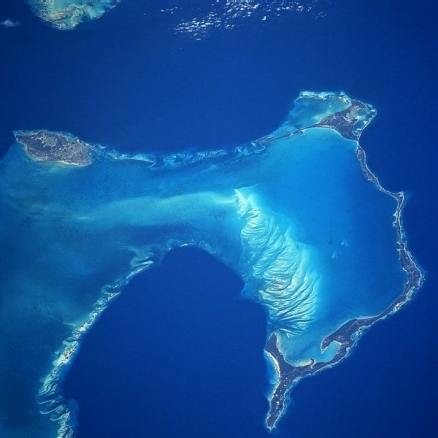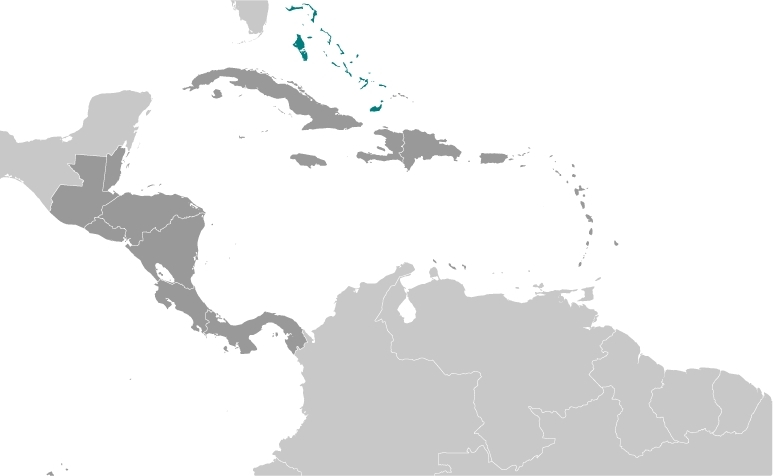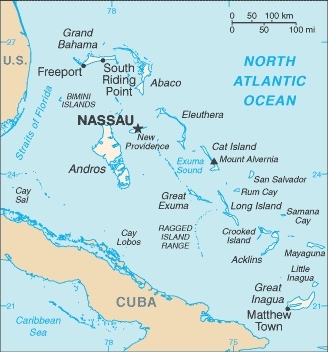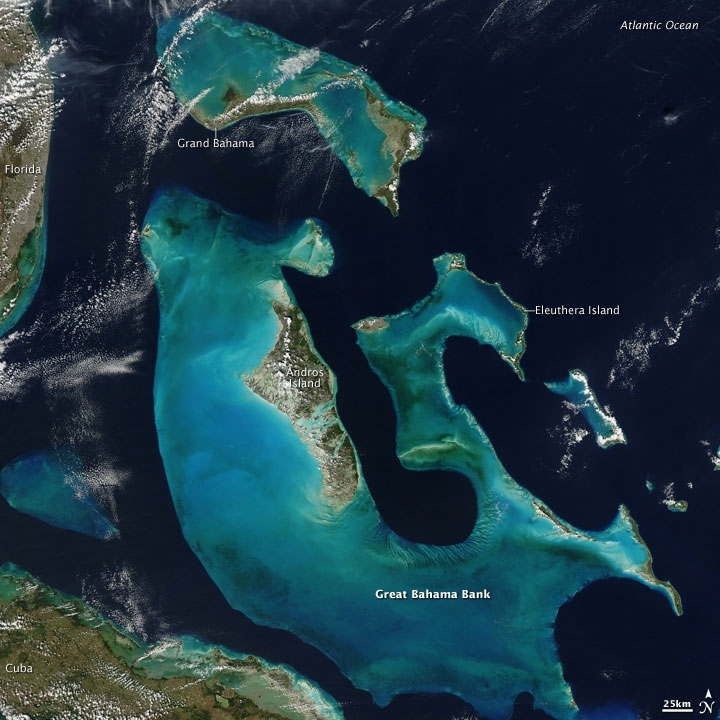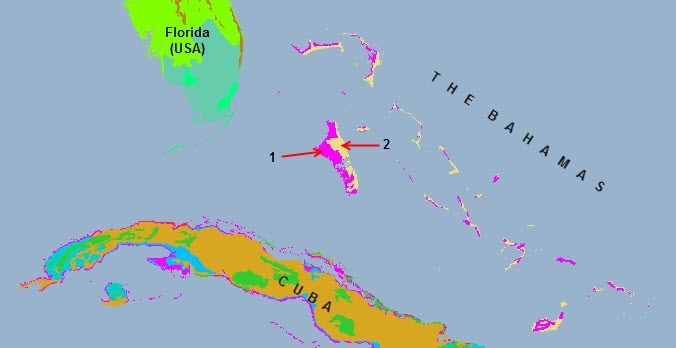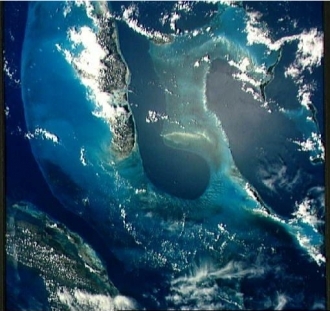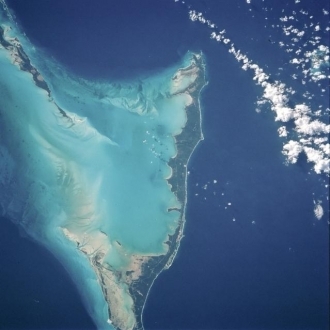Bahamas
Countries and Regions of the World Collection  The Bahamas is an independent, English-speaking country of nearly a third-of-a-million people consisting of two thousand cays and seven hundred islands that form an archipielago.
The Bahamas is an independent, English-speaking country of nearly a third-of-a-million people consisting of two thousand cays and seven hundred islands that form an archipielago.
It is located in the Atlantic Ocean; southeast of the United States; northeast to east of Cuba and the island of Hipaniola (Dominican Republic& Haiti) and north to east of the Caribbean Sea; and west to northwest of the Turks and Caicos Islands.
Its major environmental issues include coral reef decay and solid waste disposal. It is susceptible to hurricanes and other tropical storms which cause extensive flood and wind damage.
Lucayan Indians inhabited the islands when Christopher Columbus first set foot in the New World on San Salvador in 1492.
British settlement of the islands began in 1647; the islands became a colony in 1783.
Since attaining independence from the United Kingdom in 1973, The Bahamas have prospered through tourism and international banking and investment management.
Because of its geography, the country is a major transshipment point for illegal drugs, particularly shipments to the US and Europe, and its territory is used for smuggling illegal migrants into the US.
Contents
Geography
Location: Caribbean, chain of islands in the North Atlantic Ocean, southeast of Florida, northeast of Cuba
Geographic Coordinates: 24 15 N, 76 00 W
Area: 13,940 square km (10,070 sq km of land and 3,870 sq km of water)
- arable land: 0.58%
- permanent crops: 0.29%
- other: 99.13% (2005)
- Irrigated land: 10 sq km (2008)
Coastline: 3,542 km
Maritime Claims: Territorial sea out to 12 nautical miles and an exclusive economic zone out to 200 nautical miles
Natural Hazards: hurricanes and other tropical storms cause extensive flood and wind damage
Natural Resources: salt, aragonite, timber, arable land
Terrain: Long, flat coral formations with some low rounded hills. The highest point is Mount Alvernia, on Cat Island (63 meters)
Climate: Tropical marine; moderated by warm waters of Gulf Stream
East of southern Florida, large swaths of ocean water glow peacock blue. These waters owe their iridescence to their shallow depths. Near Florida and Cuba, the underwater terrain is hilly, and the crests of many of these hills comprise the islands of the Bahamas. On February 12, 2009, relatively clear skies allowed the Moderate Resolution Imaging Spectroradiometer (MODIS) on NASA’s Aqua satellite an unobstructed view of the region.
The most striking feature of this image is the Great Bahama Bank, a massive underwater hill underlying Andros Island in the west, Eleuthera Island in the east, and multiple islands in between. To the north, another bank underlies another set of islands, including Grand Bahama. The varied colors of these banks suggest their surfaces are somewhat uneven. The banks’ distinct contours, sharply outlined in dark blue, indicate that the ocean floor drops dramatically around them. In fact, over the banks, the water depth is often less than 10 meters (33 feet), but the surrounding basin plunges to depths as low as 4,000 meters (13,100 feet).
MODIS is not the only satellite to capture beautiful images of the Bahamas. The region’s ocean water, sand, and seaweed make it equally dramatic in high-resolution satellite imagery.
Source: NASA. Image created by Jeff Schmaltz, MODIS Rapid Response Team, Goddard Space Flight Center. Caption by Michon Scott.
Ecology
1. Bahamian mangroves (part of the larger Bahamoan-Atillean mangroves ecoregion)
2. Bahamian dry forests/Bahamoan pine mosaic
The Bahamian mangroves are found in a large area of shallow water that is of high importance for its ecological productivity. These coastal mangroves, together with coral reefs and seagrass beds, form a highly diverse and structurally complex ecosystem in which the reefs act as a barrier that shelters seagrass beds and mangroves from high wave energy and strong coastal currents typical of the Caribbean environment. Mangroves and seagrass beds in turn provide foraging and nursery habitats for many reef species and sea turtles that are found throughout the Bahamas.
There are at least four bird species endemic to the Bahamas islands which may utilize mangrove habitats at times including the Bahama woodstar , white-cheeked pintail, Bahamas swallow and Bahama yellowthroat; although none of them specifically live in mangrove habitat exclusively. Other bird species associated with mangroves include spotted sandpiper, roseate spoonbill, green heron, belted kingfisher, Mangrove cuckoo, mangrove warbler, and reddish egret.
Sea turtles found throughout Bahamas islands utilizing mangrove habitats include the green turtle, hawksbill, loggerhead, and leatherback. Important fish species found in Bahamian mangroves are snappers, grunts, parrotfishes, and mojarra, Nassau grouper, Bonefishbonefish, tarpon and barracuda a very important economically as a sport fishery.
Pine forests are distributed throughout the Bahamas island archipelago and Turks and Caicos Islands representing a unique habitat association in the Caribbean. The small over all geographic size of this ecoregion combined with continuing pressures from population growth and associated infrastructure development makes these pine forests particularly prone to degradation and disturbance. A history of land-use practices that include deforestation and intensive agricultural alteration of much of the original forest cover have contributed to a subsequent loss of species richness. Fortunately, logging licenses were relinquished to the Crown in 1974, which has kept tree felling localized and sporadic with allowances for natural regeneration to occur in many areas. The biodiversity includes numerous resident and migrating bird species as well as a variety of mammals and reptiles that are regionally distinct.
| Most of the Western Bahama Banks, the Tongue of the Ocean (center), and Andros Island (left), as well as north central Cuba (lower left) with its fringing reefs, may be seen in this one view. Much of the green-turquoise water over the banks is less than 9 m (30 ft) deep but the deep blue of the Tongue is 1,200 to 1,800 m (4,000 to 6,000 ft) deep. All the sediment on the banks, including the material that forms the islands, is calcium carbonate (lime) precipitated from sea water by animals and plants. Image courtesy of NASA. |
| An even more stark view of the dark blue Tongue of the Ocean whose depths reach up to 1,800 m (6,000 ft). By comparison, the waters of the Bahama Platform (light blue) are frequently less than 15 m (50 ft) deep. They are warm and become extremely salty due to evaporation and limited circulation from the open ocean. Crystals of aragonite, a calcium carbonate mineral derived from the shells of single-celled marine organisms, and direct precipitation, form into oolites (small spherical grains of limestone) as the tidal currents swirl back and forth. Lithification of the carbonate sands produces an oolite limestone. Although the water is warm and clear, corals do not live in these shallows, probably because of the salt content. Though chemically very similar, the rocks resulting from this precipitating process have a quite different origin from those formed from coral reefs. Image courtesy of NASA. |
| The vivid blues of the Bahamas stand out from space. The northern half of Long Island and the southern half of Great Exuma Island (extending to the northwest) are on the eastern side of the Great Bahama Bank and form the borders of Exuma Sound. Image courtesy of NASA. |
See also:
Protected Areas
The protected areas of the Bahamas include:
- Abaco National Park (20,500 acres)
- Central Andros Parks (286,080 acres)
- Exuma Cays Land and Sea Park (112,640 acres)
- Harrold and Wilson Ponds National Park (250 acres)
- Inagua National Park (183,740 acres)
- Lucayan National Park (40 acres)
- Moriah Harbour Cay National Park (13,440 acres)
- BNT Rand Nature Centre (100 acres)
- The Retreat (11 acres)
- Union Creek National Park (4,940)
In 2000, the Bahamas began to establish a Marine Reserve Network. Five sites were proposed for initial inclusion in the network at North Bimini, Berry Islands (Frozen Cay to Whale Cay area), South Eleuthera (Powell Point to Schooner Cays), Exuma Cays (south of the Land and Sea Park in the Lee Stocking Island area), and northern Abaco Cays. In 2002, additional sites were added.
People and Society
Eighty-five percent of the Bahamian population is of African heritage. About two-thirds of the population resides on New Providence Island (the location of Nassau). Many ancestors arrived in The Bahamas when the islands served as a staging area for the slave trade in the early 1800s. Others accompanied thousands of British loyalists who fled the American colonies during the Revolutionary War.
Haitians form the largest immigrant community in The Bahamas. 30,000-60,000 are estimated to be resident legally or illegally, concentrated on New Providence, Abaco, and Eleuthera islands.
Population: 316,182 (July 2012 est.)
Ethnic groups: black 85%, white 12%, Asian and Hispanic 3%
Age Structure:
0-14 years: 24.4% (male 38,834/female 37,715)
15-64 years: 69.2% (male 106,882/female 110,081)
65 years and over: 6.3% (male 7,578/female 12,222) (2011 est.)
Population Growth Rate: 0.904% (2012 est.)
Birthrate: 15.95 births/1,000 population (2012 est.)
Death Rate: 6.91 deaths/1,000 population (July 2012 est.)
Net Migration Rate: 0 migrant(s)/1,000 population (2012 est.)
Life Expectancy at Birth: 71.44 years
male: 69.04 years
female: 73.91 years (2012 est.)
Total Fertility Rate: 1.98 children born/woman (2012 est.)
Languages: English (official), Creole (among Haitian immigrants)
Literacy: 95.6% (2003 est.)
Education: School attendance is compulsory between the ages of 5 and 16. The government fully operates 157 of the 252 primary and secondary schools in The Bahamas. The other 95 schools are privately operated. Enrollment for state primary and secondary schools is 48,545, with more than 21,000 students attending private schools. The College of The Bahamas, established in Nassau in 1974, provides programs leading to bachelors and associates degrees. Several non-Bahamian colleges also offer higher education programs in The Bahamas.
Urbanization: 84% of total population (2010) growing at a 1.3% annual rate of change (2010-15 est.)
Access to improved water sources: 96% of population
Access to improved sanitation facilities: 100% of population
History
In 1492, Christopher Columbus made his first landfall in the Western Hemisphere in The Bahamas. Spanish slave traders later captured native Lucayan Indians to work in gold mines in Hispaniola, and within 25 years, all Lucayans perished. In 1647, a group of English and Bermudan religious refugees, the Eleutheran Adventurers, founded the first permanent European settlement in The Bahamas and gave Eleuthera Island its name. Similar groups of settlers formed governments in The Bahamas until the islands became a British Crown Colony in 1717.
The late 1600s to the early 1700s were the golden age for pirates and privateers. Many famous pirates and privateers--including Sir Francis Drake and Blackbeard--used the islands of The Bahamas as a base. The numerous islands and islets with their complex shoals and channels provided excellent hiding places for the plundering ships near well-traveled shipping lanes. The first Royal Governor, Woodes Rogers, brought law and order to The Bahamas in 1718 when he expelled the buccaneers.
During the American Revolution, American colonists loyal to the British flag settled in The Bahamas. These Loyalists and new settlers from Britain brought Colonial building skills and agricultural expertise. Until 1834, when Britain abolished slavery, they also brought slaves, importing the ancestors of many modern Bahamians from Western Africa.
Proximity to the U.S. continued to provide opportunity for illegal shipping activity. In the course of the American Civil War, The Bahamas prospered as a center of Confederate blockade-running. During Prohibition, the islands served as a base for American rumrunners. Today, The Bahamas is a major transshipment point for narcotics on the way to the U.S.
Bahamians achieved self-government through a series of constitutional and political steps, attaining internal self-government in 1964 and full independence within the Commonwealth on July 10, 1973. Since independence, The Bahamas has continued to develop into a major tourist and financial services center.
Government
The Bahamas is an independent member of the Commonwealth of Nations. It is a parliamentary democracy with regular elections. As a Commonwealth country, its political and legal traditions closely follow those of the United Kingdom. The Bahamas recognizes Queen Elizabeth II as its head of state, while an appointed Governor General serves as the Queen's representative in The Bahamas. A bicameral legislature enacts laws under the 1973 constitution.
House of Assembly members are elected from individual constituencies for 5-year terms. In 2011, the number of seats was reduced from 41 to 38. As under the Westminster system, the government may dissolve the Parliament and call elections at any time. The House of Assembly performs all major legislative functions. The leader of the majority party serves as prime minister and head of government. The Cabinet consists of at least nine members, including the prime minister and ministers of executive departments. They answer politically to the House of Assembly.
The Senate consists of 16 members appointed by the Governor General, including nine on the advice of the Prime Minister, four on the advice of the Leader of the Opposition, and three on the advice of the Prime Minister after consultation with the Leader of the Opposition.
Government Type: Constitutional parliamentary democracy and a Commonwealth realm
Capital: Nassau - population: 248,000 (2009)
Independence Date: Independence Day, 10 July (1973)
Legal System: based on English common law. The Governor General appoints the Chief Justice of the Supreme Court on the advice of the Prime Minister and the Leader of the Opposition. The Governor General appoints the other justices with the advice of the Judicial and Legal Services Commission. The Privy Council of the United Kingdom is the highest Court for The Bahamas. The Court of Appeal is separate from the Supreme Court, comprised of a President, three resident Justices of Appeal and one non-resident Justice of Appeal. The Chief Justice is part of the Court of Appeal by virtue of his title as Head of Judiciary.
Administrative Divisions: The Bahamas is composed of 31 administrative districts; Acklins Islands, Berry Islands, Bimini, Black Point, Cat Island, Central Abaco, Central Andros, Central Eleuthera, City of Freeport, Crooked Island and Long Cay, East Grand Bahama, Exuma, Grand Cay, Harbour Island, Hope Town, Inagua, Long Island, Mangrove Cay, Mayaguana, Moore's Island, North Abaco, North Andros, North Eleuthera, Ragged Island, Rum Cay, San Salvador, South Abaco, South Andros, South Eleuthera, Spanish Wells, West Grand Bahama Local government districts elect councils for town planning, business licenses, traffic issues and maintaining government buildings. In some large districts, lower level town councils also have minor responsibilities.
International Environmental Agreements
The Bahamas is party to international agreements on: Biodiversity, Climate Change, Climate Change-Kyoto Protocol, Desertification, Endangered Species, Hazardous Wastes, Law of the Sea, Ozone Layer Protection, Ship Pollution, and Wetlands.
Economy
The Bahamas is one of the wealthiest Caribbean countries with an economy heavily dependent on tourism and offshore banking.
Tourism together with tourism-driven construction and manufacturing accounts for approximately 60% of GDP and directly or indirectly employs half of the archipelago's labor force. Prior to 2006, a steady growth in tourism receipts and a boom in construction of new hotels, resorts, and residences led to solid GDP growth but since then tourism receipts have begun to drop off. In 2008, 4.6 million tourists visited The Bahamas, 85% from the United States. The number of visitors declined in 2009 due to the global economic crisis, but by December 2010, The Bahamas once again enjoyed 5 million visitors. This was a 4.5% year-on-year decrease from 2007.
In addition to the decrease in tourism, other economic challenges facing The Bahamas include meeting continued employment demands, jumpstarting a lagging privatization process, and monitoring increasing levels of government debt. Currently, Bahamians do not pay income or sales taxes. Most government revenue is derived from high tariffs and import fees. Reduction of trade barriers will probably require some form of taxation to replace revenues. Government as well as private sector leaders have voiced the need for a value added tax (VAT). The Bahamas is taking steps toward its goal of joining the World Trade Organization. In December 2008 the Bahamian Government signed an Economic Partnership Agreement (EPA) with the European Union (EU).
A number of planned hotel projects have promised to increase economic growth and create short- and long-term employment. The Atlantis Resort and Casino on Paradise Island remains a major tourist draw and an engine of the economy; this resort is currently planning its "4th phase" of upgrades. In March 2009 the ExIm Bank of China formally agreed to $2.6 billion in financing for the major BahaMar resort project. Parliament also approved the contentious request for 8,150 mostly Chinese laborers to work on the project. The government is currently redeveloping Nassau’s Lynden Pyndling International Airport and has turned over its management to private operators. The new U.S. arrivals and departures terminal at the airport was completed in March 2011. The Bahamian Government also has adopted a proactive approach to courting foreign investors and has conducted major investment missions to Asia, Europe, Latin America, India, and Canada. The government continues to pay particular attention to China to encourage tourism and investment. The Bahamas has opened an embassy in Beijing; the Chinese are funding the construction of a new $30 million sports stadium in New Providence and are providing more than $100 million in road construction projects. While the FNM government has expressed a desire to increase Bahamian ownership interests in developments, The Bahamas' dependence on foreign investment is unlikely to change.
Financial services constitute the second-most important sector of the Bahamian economy and, when combined with business services, account for about 36% of GDP. However, the financial sector currently is smaller than it has been in the past because of the enactment of new and stricter financial regulations in 2000 that caused many international businesses to relocate elsewhere. The Stop Tax Haven Abuse bill, which has been proposed in the U.S. Congress and which names The Bahamas as one of 34 secrecy jurisdictions, has generated considerable discussion in local media and amongst politicians. Many Bahamians feel the inclusion of The Bahamas in such a bill would result in significant job losses in the financial services sector. As of 2005, the government had licensed 262 banks and trust companies in The Bahamas. The Bahamas promulgated the International Business Companies (IBC) Act in January 1990 to enhance the country's status as a leading financial center. The act served to simplify and reduce the cost of incorporating offshore companies in The Bahamas. Within 9 years, more than 84,000 IBC-type companies had been established. In February 1991, the government also legalized the establishment of Asset Protection Trusts in The Bahamas. In 2000, in response to multilateral organizations' concerns, the government passed a legislative package of stronger measures to better regulate the financial sector and prevent money laundering in the country's banking sector, including creation of a Financial Intelligence Unit and enforcement of "know-your-customer" rules. Some of these measures have been challenged in Bahamian courts, and the number of offshore banks registered in The Bahamas has declined substantially since 2002. As many as half of the IBCs have also closed shop. The government is considering additional legislation to keep the industry competitive while complying with international standards, including possible reform of the regulatory structure. As of March 2010, The Bahamas had signed 20 bilateral Tax Information Exchange Agreements, 14 with Organization for Economic Cooperation and Development (OECD) members and seven with G-20 members. These agreements helped The Bahamas avoid placement on the OECD “gray” list of countries that are not compliant with OECD tax information exchange regulations.
Manufacturing and agriculture combined contribute approximately a tenth of GDP and show little growth, despite government incentives aimed at those sectors.
Agriculture and fisheries together account for about 1% of GDP. The Bahamas exports lobster and some fish but does not raise these items commercially. There is no large-scale agriculture, and most agricultural products are consumed domestically. Following an outbreak of citrus canker on Abaco in 2005, The Bahamas lost a main agricultural export, and the Ministry of Agriculture banned the export of plant materials from Abaco. The Bahamas imports more than $250 million in foodstuffs per year, representing about 80% of its food consumption.
The Bahamas imports nearly all its food and manufactured goods from the United States. American goods and services tend to be favored by Bahamians due to cultural similarities and heavy exposure to American advertising. The Bahamian economy, due to its heavy dependence on U.S. tourism and trade, is deeply affected by U.S. economic performance.
Overall growth prospects in the short run rest heavily on the fortunes of the tourism sector and foreign investment in tourism related infrastructure projects. The government also completed the sale of 51% of the telecommunications company in 2011 after 14 years of trying to privatize the state-owned enterprise.
The Bahamian Government maintains the value of the Bahamian dollar on a par with the U.S. dollar. The Bahamas is a beneficiary of the U.S.-Caribbean Basin Trade Partnership Act (CBTPA), Canada's CARIBCAN program, and the EU’s Economic Partnership Agreement. Although The Bahamas participates in the political aspects of the Caribbean Community (CARICOM), it has not entered into joint economic initiatives, like the CSME, with other Caribbean states.
The Bahamas has a few notable industrial firms: the pharmaceutical firm PFC Bahamas (formerly Syntex); the BORCO oil facility, doing business as Vopak Terminal Bahamas; Sands Beer; and the Bahamian Brewery in Grand Bahama, all in Freeport; and the Commonwealth Brewery in Nassau, which produces Heineken, Guinness, and Kalik beers. Other industries include sun-dried sea salt in Great Inagua, a wet dock facility in Freeport for repair of cruise ships, and mining of aragonite--a type of limestone with several industrial uses--from the sea floor at Ocean Cay.
The Hawksbill Creek Agreement established a duty-free zone in Freeport, The Bahamas' second-largest city, with a nearby industrial park to encourage foreign industrial investment. The Hong Kong-based firm Hutchison Whampoa operates the container port in Freeport. The Bahamian Parliament approved legislation in 1993 that extended most Freeport tax and duty exemptions through 2054.
GDP: (Purchasing Power Parity): $10.81 billion (2011 est.)
GDP: (Official Exchange Rate): $8.1 billion (2011 est.)
GDP- per capita (PPP): $30,900 (2011 est.)
GDP- composition by sector:
agriculture: 1.6%
industry: 8%
services: 90.4% (2011 est.)
Industries: tourism, banking, cement, oil transshipment, salt, rum, aragonite, pharmaceuticals, spiral-welded steel pipe
Exports: mineral products and salt, animal products, rum, chemicals, fruit and vegetables
Imports: machinery and transport equipment, manufactures, chemicals, mineral fuels; food and live animals
Currency: Bahamian dollars (BSD)
